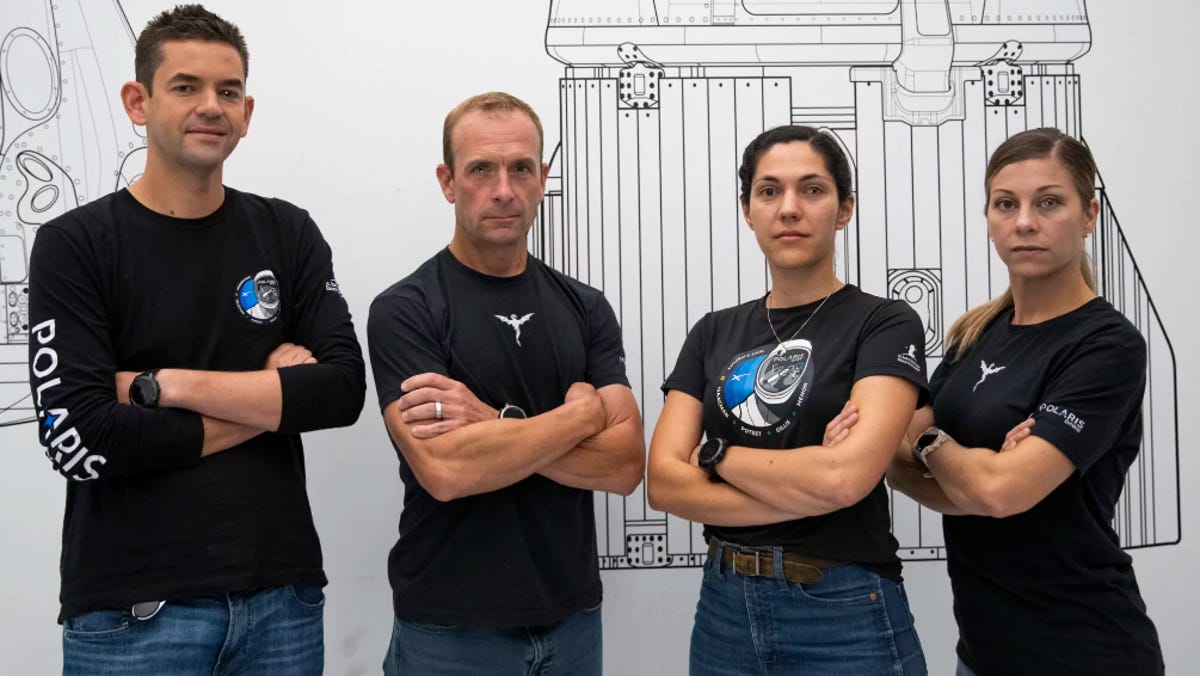SpaceX Polaris Dawn mission sets stage for first commercial spacewalk
When SpaceX launches the Polaris Dawn mission this month, it will go higher than any crewed mission since Apollo – but there’s more to the story.
How do you solve space motion sickness — so astronauts aren’t “nauseous and potentially throwing up” the entire mission?
How do you test a new spacesuit to ensure it not only works in weightlessness, but also in the vacuum of space?
And, finally, what will launching into space feel like?
Those are some of the questions the crew of the upcoming Polaris Dawn mission have been focusing on as they prepare for their history-making civilian mission − slated to liftoff in a SpaceX Dragon atop a Falcon 9 rocket from Cape Canaveral early Tuesday.
FLORIDA TODAY interviewed two of the crew members of Polaris Dawn: Sarah Gillis, who is an astronaut trainer at SpaceX, and Anna Menon, who oversees crew operations and works in mission control at SpaceX.
They are joining billionaire and businessman, Jared Isaacman (who also commanded the first all civilian mission to orbit, Inspiration4) and former Air Force Lieutenant Colonel, Scott “Kidd” Poteet, who will serve as the Polaris Dawn pilot.
In a wide-ranging interview well before pre-launch quarantine, Gillis and Menon talked about the new SpaceX spacesuits that will be necessary for all four crew members to wear during Isaacman’s spacewalk, some of the other experiments the team will be conducting in space, how they expect to be feeling on launch day, and what treats they are bringing up to orbit.
How did SpaceX test the new spacesuits
When is the next Florida launch? Is there a launch today? Upcoming SpaceX, NASA rocket launch schedule from Florida
Q: It’s a first of it’s kind, as the previous SpaceX suits were never designed to be used outside the spacecraft. What kind of training do you have as far as the new spacesuits?
Gillis: What is so cool about this mission, though, is that we get to create a whole new training component because we’ve never had to train for a spacewalk before. So, we obviously started with our standard training program — which is what every NASA crew member goes through for living and flying in Dragon.
And then we took a look at what are the skills that we need to train to actually accomplish the spacewalk. There’s everything from the physical movements inside the suit and understanding the environment you’re in and how you move, operate, and function.
There’s also the mental components of taking on this challenge as a team and how you work as a crew — and how you ensure you’re really prepared. And we took a look at all sides of it.
The SpaceX team — they were in the process of building a brand new spacesuit to support this, and rather than go the traditional route of taking that suit and putting it in the water, which is the analog that NASA has used for a while for training spacewalks — we didn’t have the luxury of having two suits, one that could go in water and one that could be used and dry air.
We were building the suits actively. So instead, they found this really awesome and innovative solution to basically take our suit, put it in a suspension harness, and then put specific physics models on a hoist. And in doing so, you can create a microgravity simulator — where you’re able to fully pressurize the suit.
We’ve run, you know, pretty much every scenario the ground sim (simulation) supervisors can come up with to challenge us — all of the abort conditions, the termination criteria — so we feel that we really are prepared stepping into this.
Q: When the Dragon hatch is opened, you will all be exposed to the vacuum of space. What testing has SpaceX done to ensure the suits function in that environment?
Menon: We absolutely know the suits can pressurize there. They have gone through so much extensive testing on the ground here at SpaceX — it’s really incredible with hardware.
We’ll be taking those suits and testing them in a vacuum chamber in Houston as the final acceptance test. We’ve spent a lot of time pressurizing the suits at this point.
What is SpaceX’s goal for the new spacesuits
Q: How do you see the SpaceX spacesuits being a game changer in the space industry, especially with commercial space coming on board?Menon: You know, I think that this is a stepping stone for some of SpaceX’s long term ambitions but also, human spaceflight long term ambition. SpaceX envisions a world where human life is multiplanetary — and that we are one day putting people on the surface of Mars.
The human spaceflight efforts are starting to put people back on the surface of the moon. There are a lot of grand goals out there, and a lot of those efforts require spacesuits to do that. If you are going to go all the way to the moon or all the way to Mars, you’re going to want to get outside your spacecraft and step foot on that other surface. And so you need a spacesuit to do that.
I think having additional capabilities out there — additional learning — we can all share that learning and learn from each other. It’s only good for the future of human spaceflight.
What else is the Polaris Dawn mission focused on?
Q: What experiments or objectives are you going to partake in during the mission?
Menon: We have about 40 science and research experiments that we are doing as a part of this mission. And so basically, we have a few major mission objectives.
That’s the high altitude flight, the first ever commercial spacewalk, and the testing of Starlink laser communication system for a Dragon human spacecraft.
But then, basically every moment in between those major mission objectives, we’ll be doing science and research while we’re up there. We are making it important to us that every minute is used to contribute to long term human spaceflight endeavors, and to the betterment of human life.
And so the science that we’re tackling spans a lot of different areas, but a lot of it is really trying to help solve problems that we will need to solve in order to make life multiplanetary.
To give some examples, a handful of experiments tackle space motion sickness, which is an issue that plagues 60% of astronauts when they first hit microgravity. It renders them nauseous, potentially throwing up, pretty nonfunctional in many cases for about the first three days as they become accustomed to this new environment.
If you imagine a world where we’re sending 100 people into space at the same time, you’d have 60 people floating around vomiting. That’s not going to make for a very clean or productive spacecraft. So really, solving this, better understanding who gets this, and how to mitigate it, is going to be really important for our future spaceflight endeavors.
Another category of science research that we’re doing deals with the vision problems that plague astronauts, when they’re in microgravity for extended durations of time. There’s a syndrome called Spaceflight Associated Neuro Ocular Syndrome.
There’s already been some great research on this by NASA and others on the International Space Station. But there’s still a lot to learn about. There’s still a lot to be done to understand exactly the mechanisms causing it.
What is the Polaris Dawn mission timeline
Q: How long is the mission going to be?
Gillis: Our mission timeline for our flight is five days. We have consumables for about 120 hours. There’s also plenty of margin after that, but really, our expected timeline is about 120 hours. If weather degrades, and we need to come home early, we certainly can. But as Anna mentioned, we have a really, really full schedule so hopefully we’ll be able to see that full time on orbit.
Polaris Dawn launch day
Q: What do you anticipate launch day? How is the launch day going to play out?
Gillis: We would probably spend seven or 10 days at the Cape ahead of launch. We do have a week of training, and that’s like a refresher of the pad systems and what to expect as we go through the day of launch.
We also will, you know, watch the static fire of our of our rocket, and get to see it as it rolls out to the pad.
So (there’s) some really cool pre-launch milestones that we’ll go through.
By the time we’re actually at day of launch, we’ve simulated the launch sequence so many times, hopefully there’s no surprises, and it’s kind of smooth and we have good weather.
I’m so interested to see what my emotions are going through that moment. I think it’ll be a lot to process, and just wonderful to finally get to ride on this incredible rocket and spacecraft that the SpaceX team has built over so, so much time and tested for so long.
I will definitely be thinking of all of the engineers that performed the design, and the testing, and the validation of our system. So excited to get there.
Menon: We’ve heard from people that they get into the spacecraft and it feels just like they’re in the simulator —because they have rehearsed so many times.
Gillis: That’s what’s super cool about the training — is that really does prepare you for the nominal and the off nominal, and exactly what you need to do in every situation.
Treats on Dragon: What do you eat in space?
Q: Fun question — Are there any treats that you plan to bring along?
Menon: Well, the SpaceX team has solved food in a really creative way. They pack us about a days or so worth of fresh food. They pack it in a cooler, and the way they keep it cool and fresh is by freezing cold brew coffee. And so, as the coffee ice packs thaw, and we get to drink the coffee, and it keeps food wonderfully prepared for us. So things like pizza in space, sandwiches in space, vegetables in space, things like that are very, very appreciated.
And then we get more like the camping variety of food, which we also love and are great with — things like Clif Bars.
Q: Is there anything about the Polaris Dawn mission you would like to add?
Menon: I think the Polaris Program and the Polaris Dawn endeavors are to be building blocks for the future of human space exploration and for our collective future. But it also really strives to make a difference for the here and now today, too.
We don’t want to ignore the problems that we face here on Earth. And so one of the ways that we’re doing that is by continuing to raise funds and awareness for St. Jude Children’s Research Hospital. Our commander, Jared Isaacman, flew on a mission before ours – Inspiration 4 – and on that mission they raised over $250 million for St. Jude.
Brooke Edwards is a Space Reporter for Florida Today. Contact her at [email protected] or on X: @brookeofstars.

Dr. Sarah Adams is a scientist and science communicator who makes complex topics accessible to all. Her articles explore breakthroughs in various scientific disciplines, from space exploration to cutting-edge research.






